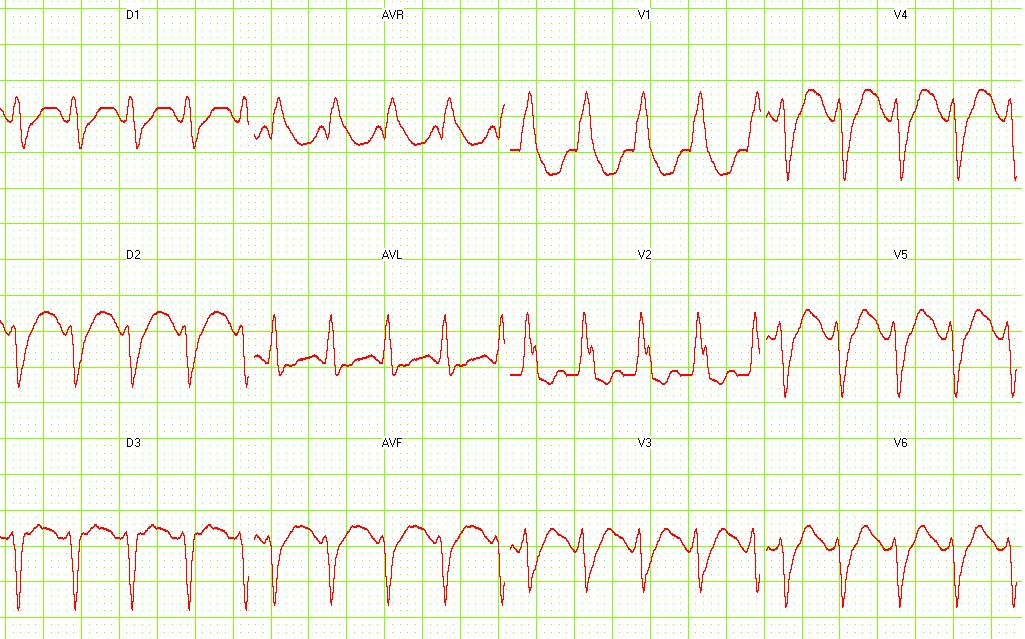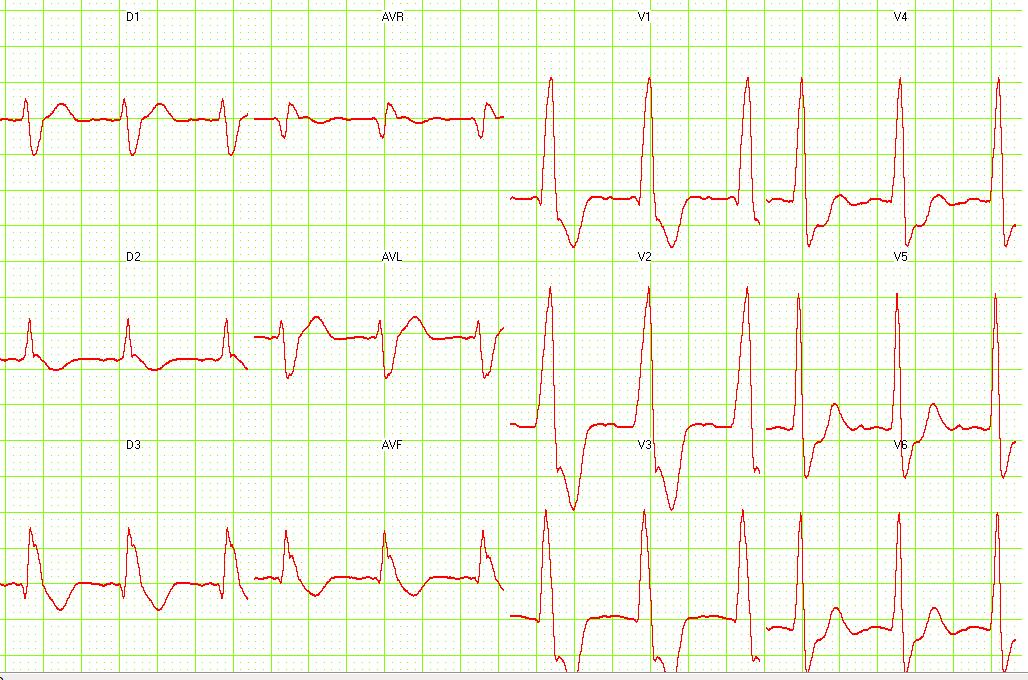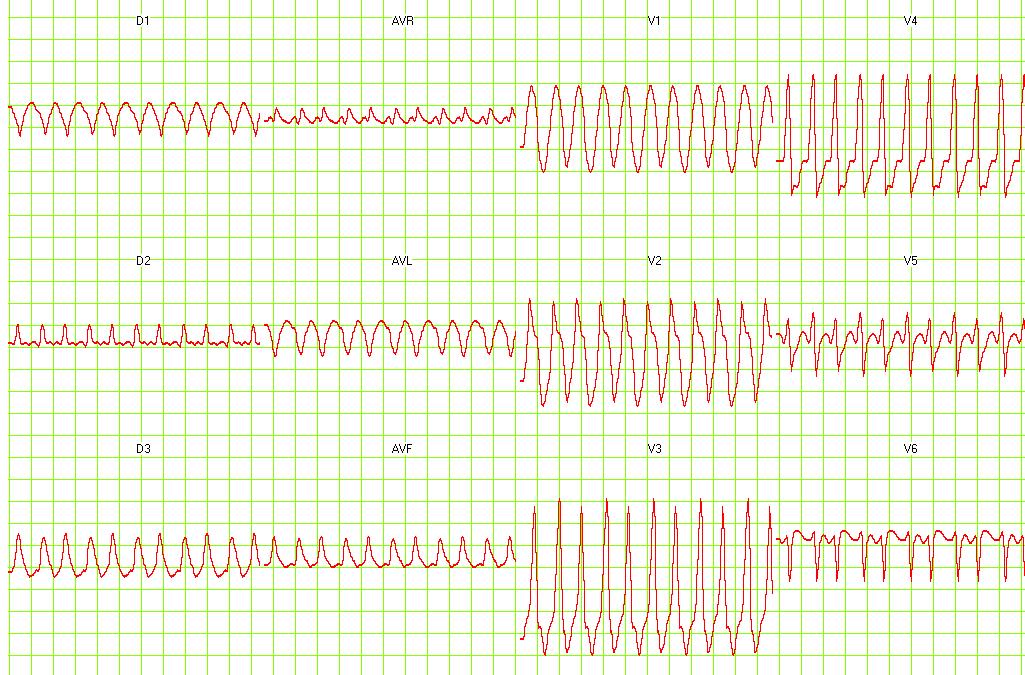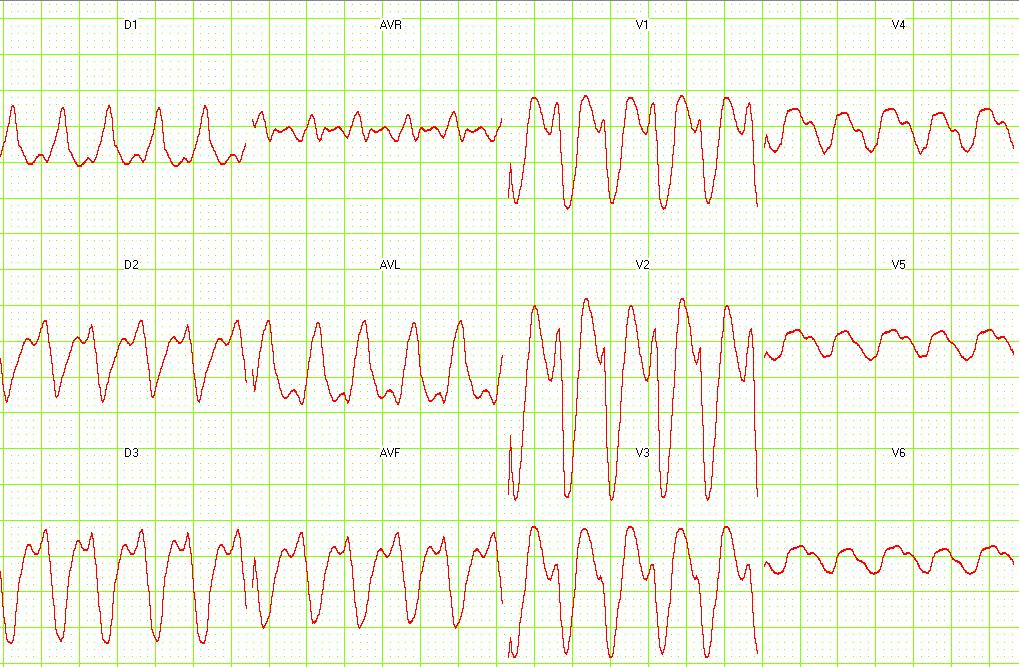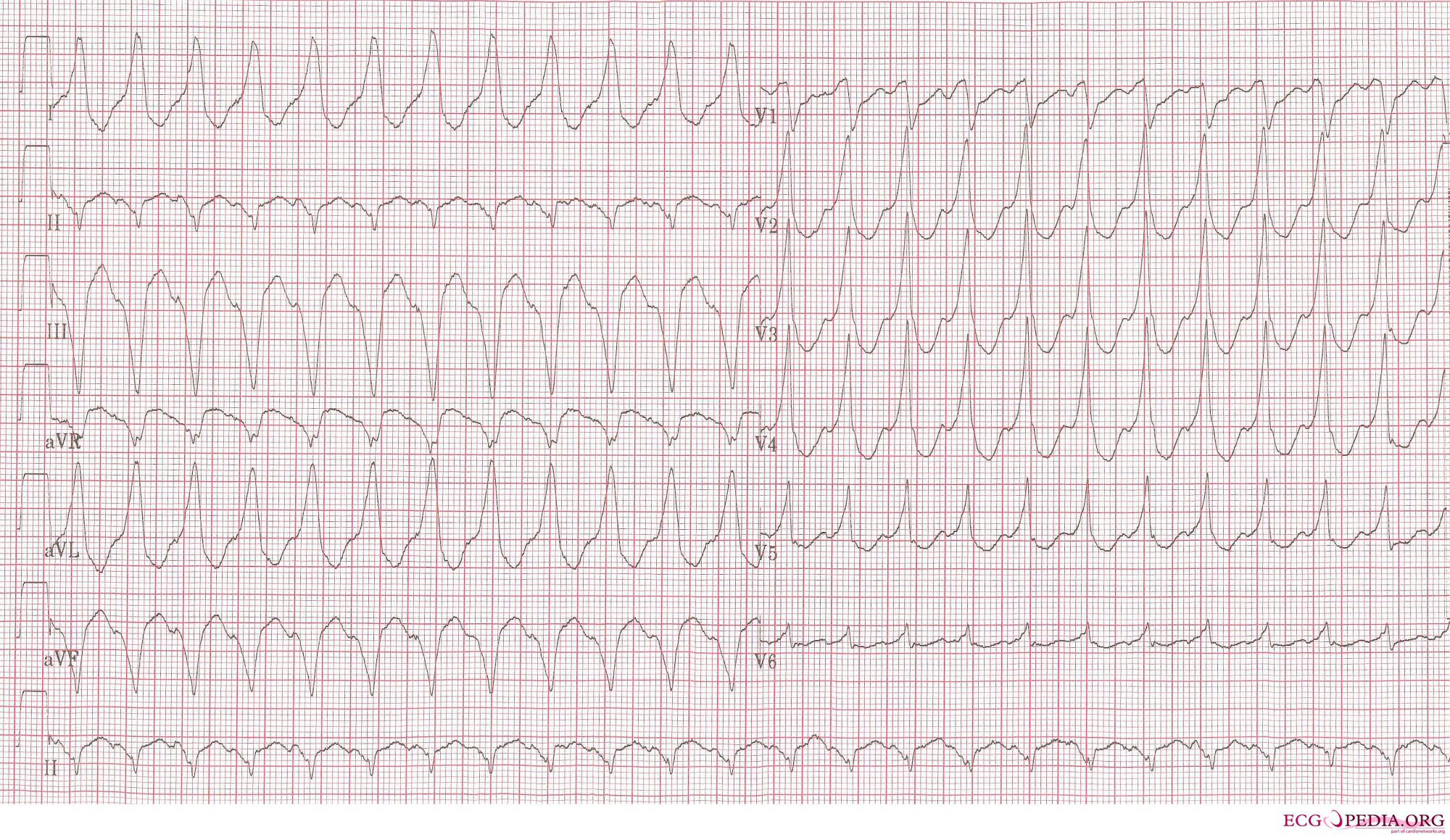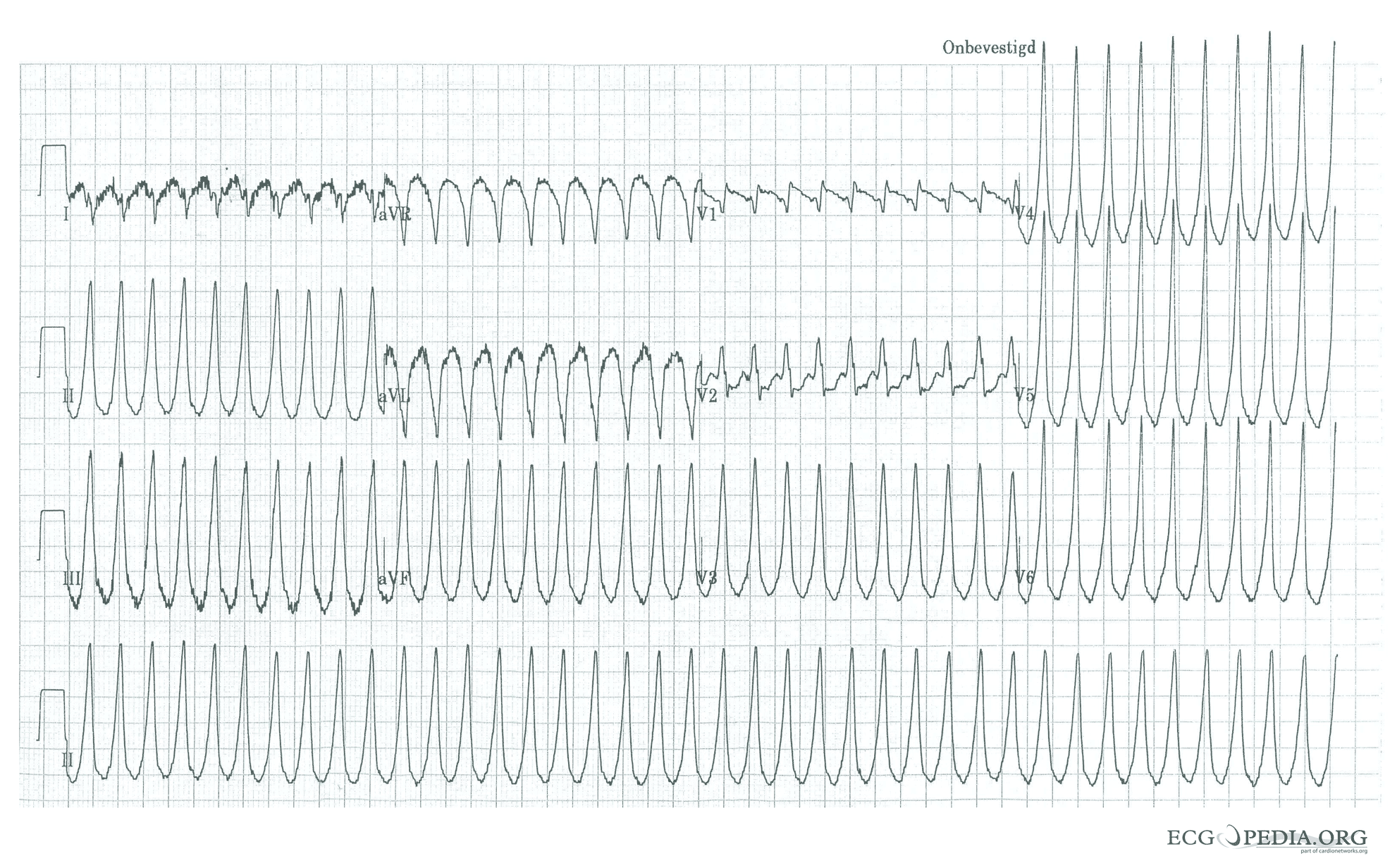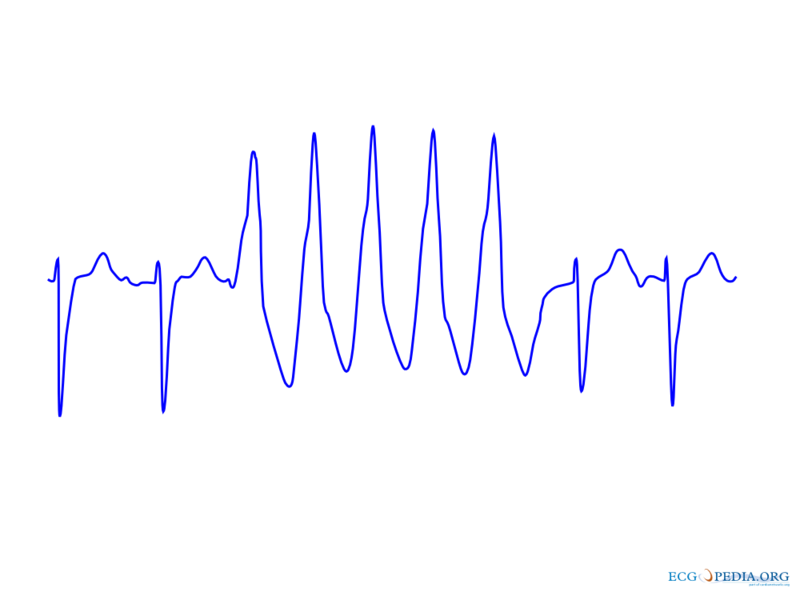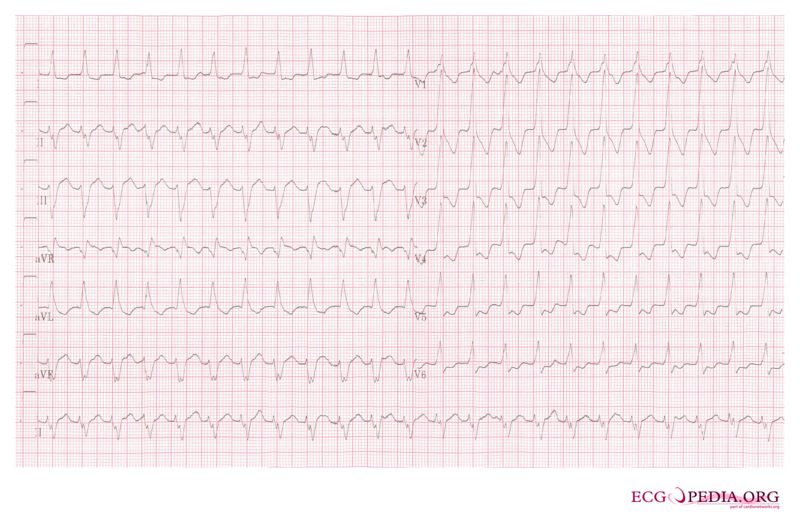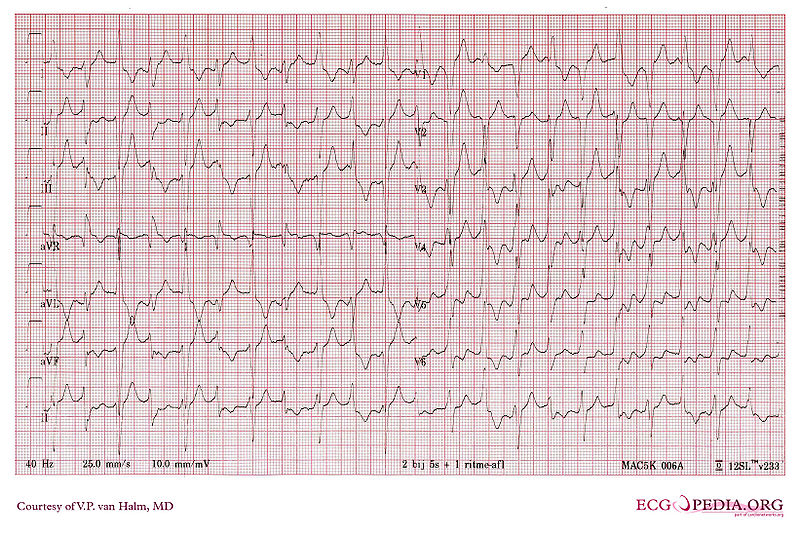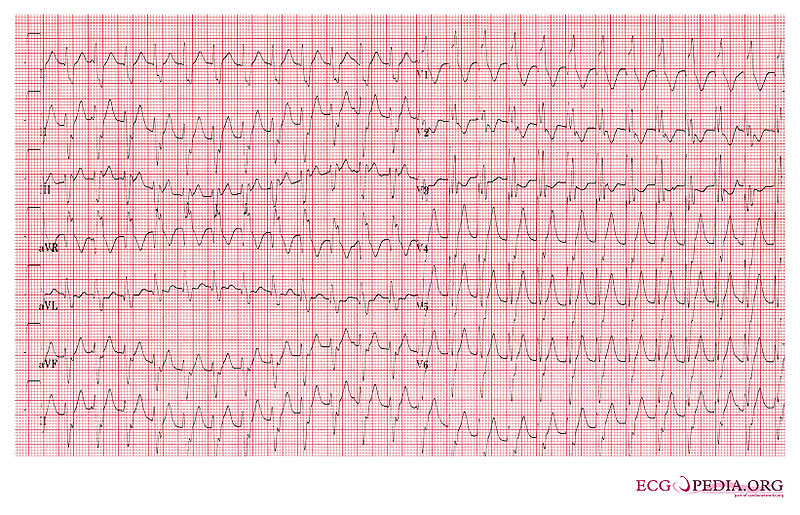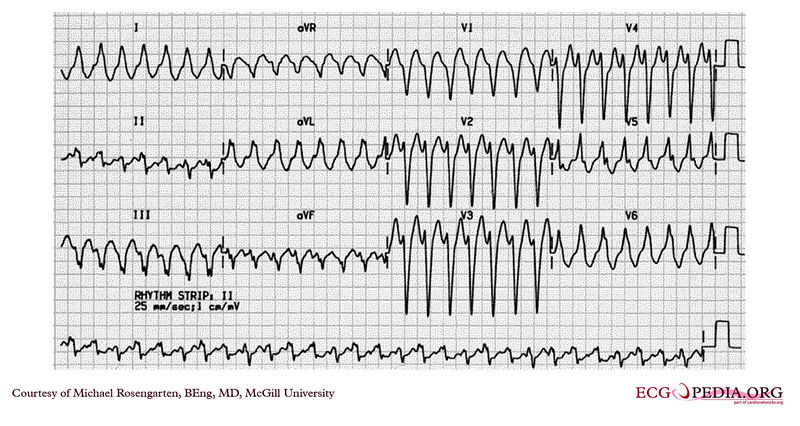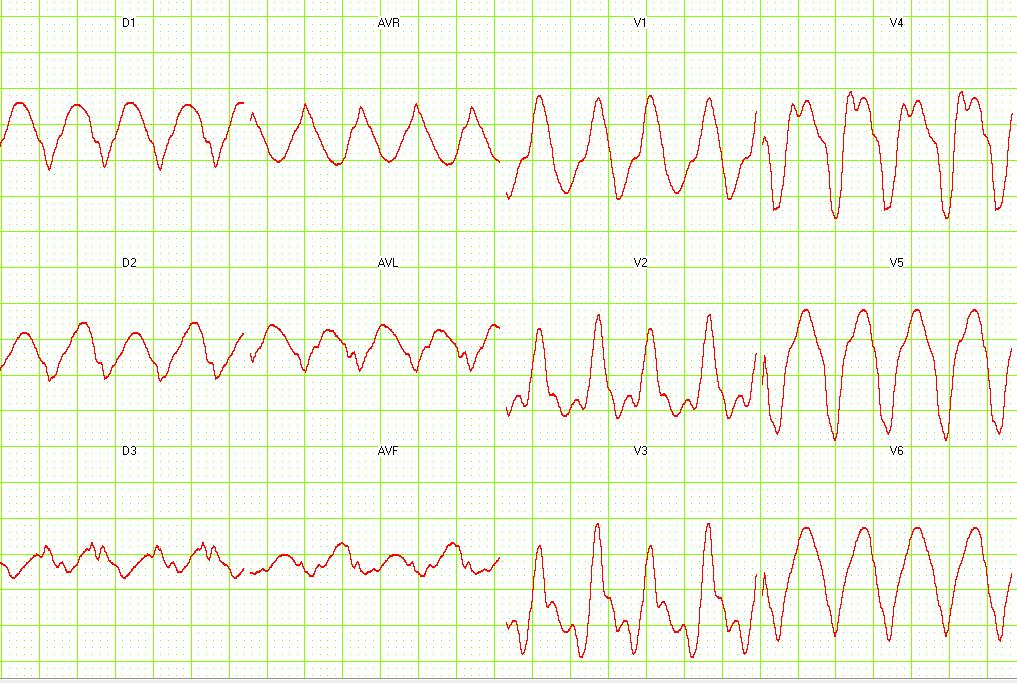|
Ventricular tachycardia Microchapters |
|
Differentiating Ventricular Tachycardia from other Disorders |
|---|
|
Diagnosis |
|
Treatment |
|
Case Studies |
|
Ventricular tachycardia electrocardiogram On the Web |
|
to Hospitals Treating Ventricular tachycardia electrocardiogram |
|
Risk calculators and risk factors for Ventricular tachycardia electrocardiogram |
Editor-In-Chief: C. Michael Gibson, M.S., M.D. [1]; Associate Editor-in Chief: Sara Zand, M.D.[2] Avirup Guha, M.B.B.S.[3]; Priyamvada Singh, M.D. [4]
Overview[edit | edit source]
Finding on ECG associated with VT include: AV dissociation, atypical right bundle branch block or left bundle branch block characteristics, QRS> 140 ms for wide complex tachycardia with right bundle branch block pattern and QRS > 160 ms for wide complex tachycardia with left bundle branch block pattern, concordance or same polarity in all precordioal leads, rightward superior QRS axis.
Electrocardiogram[edit | edit source]
Common ECG criteria associated with VT include:[1]
- The key diagnostic criterion for VT especially when the ventricular rate exceeds the atrial rate
- The absence of AV dissociation does not rule out VT
- The series of QRS complexes uncoupled from dissociated P waves
- Limiting the atrial rhythm by self‐governing ventricular rhythm
- Capture beat or single QRS complex resembling the patient's baseline rhythm due to stopping ventricular depolarization by supraventricular impulse
- Fusion beat or a hybrid QRS complex resembling the ventricular depolarization characteristics of the VT and baseline rhythm
- If ventricular impulses conduct retrograde through the His‐Purkinje system to depolarize the atria, VT will not exhibit atrioventricular dissociation.
- Morphologic criteria
- VT is the most likely diagnosis if a wide QRS tachycardia demonstrates a QRS patten incompatible with typical right or left bundle branch block characteristics.
- In the presence of wide QRS tachycardia with atypical right bundle block characteristics including monophasic R wave in V1 or V2 and QS pattern in V6, VT is the most likely diagnosis.
- When there is wide complex tachycardia with classic left bundle branch block pattern ( r wave onset to S wave nadir <60 ms in V1 or V2 and notched monophasic R wave in V6), supraventricular tachycardia is the most likely diagnosis.
- QRS duration
- QRS >140 ms for wide complex tachycardia with right bundle branch block pattern and QRS >160 ms for wide complex tachycardia with left bundle branch block pattern indicating ventricular tachycardia.
- QRS >160 ms may also be seen in supraventricular tachycardia especially among patients with ongoing antiarrhythmic use, electrolyte disturbances, conduction delays, or severe underlying structural heart disease or cardiomyopathies.
- Fascicular VT may demonstrate substantial impulse propagation within the conduction system with QRS durations <120 ms
- Chest Lead Concordance
- QRS complexes in all 6 precordial leads (V1–V6) uniformly shown a monophasic pattern with same polarity ( R for positive concordance and QS for negative concordance)
- Wide complex tachycardias with positive concordance demonstrating VT originating from the posterobasal left ventricle.
- Wide complex tachycardias with negative concordance may arise from VT originating for the anteroapical left ventricle
- Absence of concordance does not rule out VT diagnosis.
- QRS Axis
- Rightward superior QRS axis ( northwest axis) between −90° and −180°
- Dominant R wave in lead avR
- Coexistence of left‐ or right‐axis deviation with right or left bundle branch block
- In the presence of scar‐related VT mapped to the anterolateral wall of the left ventricle may show a wide complex tachycardia with an atypical right bundle branch block pattern and rightward and superior QRS axix which is uncommon in supraventricular tachycardia with right bundle branch block aberrancy.
- Differences in Ventricular Activation Velocity
- slurred initial components of the QRS complex due to slower cardiomyocyte‐to‐cardiomyocyte conduction ( R wave peak time in lead II ≥50 ms, or RS interval ≥100 ms in any of the precordial leads [V1–V6])
- Rapid propagates from conduction system and activation the remainder of the myocardium
- Rapid or sharper deflections in the terminal portion of QRS complex ( the ratio of the voltage excursion during the initial [Vi] and terminal [Vt] 40 ms of the QRS complex <1)
- Comparison to the baseline ECG
- Findings the changes in the QRS axis, T axis, and QRS duration between wide complex tachycardia and baseline ECG ( an ECG taken before or after tachycardia maybe helpful for diagnosis of VT.
| Limb leads algorithm | |||||||||||||||||||||||||||||||||||||||||||||||||||||||
RWPT algorithm
| The VT score
| ||||||||||||||||||||||||||||||||||||||||||||||||||||||
Brugada algorithm
| Ventricular tachycardia algorithm | Vereckie avR algorithm
| |||||||||||||||||||||||||||||||||||||||||||||||||||||
Pachon scoring algorithm
| |||||||||||||||||||||||||||||||||||||||||||||||||||||||
EKG Examples[edit | edit source]
Shown below is an EKG with a rapid ventricular rate of nearly 190 beats per minute with wide QRS complex in all leads depicting ventricular tachycardia.
Copyleft image obtained courtesy of ECGpedia,http://en.ecgpedia.org/wiki/Main_Page
Shown below is an EKG with a rapid ventricular rate of nearly 150 beats per minute with wide QRS complex in all leads depicting ventricular tachycardia.
Copyleft image obtained courtesy of ECGpedia,http://en.ecgpedia.org/wiki/Main_Page
Shown below is an EKG with a rapid ventricular rate of nearly 250 beats per minute with wide QRS complexes in all leads depicting ventricular tachycardia.
Copyleft image obtained courtesy of ECGpedia,http://en.ecgpedia.org/wiki/Main_Page
Shown below is an EKG with a rapid ventricular rate of nearly 215 beats per minute with wide QRS complexes in all leads depicting ventricular tachycardia.
Copyleft image obtained courtesy of ECGpedia,http://en.ecgpedia.org/wiki/Main_Page
Shown below is an EKG with a rapid ventricular rate of nearly 140 bpm with a left bundle branch block pattern and left heart axis.
Copyleft image obtained courtesy of ECGpedia,http://en.ecgpedia.org/wiki/Main_Page
Shown below is an EKG depicting ventricular tachycardia with a rate of 250 bpm, and a right bundle branch block pattern with a right heart axis.
Copyleft image obtained courtesy of ECGpedia,http://en.ecgpedia.org/wiki/Main_Page
Shown below is an EKG depicting ventricular tachycardia with a rate of 150 bpm, and a right bundle branch block pattern with right heart axis. The 5th and 6th complexes from the right side are fusion complexes. Furthermore this EKG shows baseline drift, which is a technical artefact
Copyleft image obtained courtesy of ECGpedia,http://en.ecgpedia.org/wiki/Main_Page
Shown below is an EKG depicting a nonsustained VT of five beats duration.
Copyleft image obtained courtesy of ECGpedia,http://en.ecgpedia.org/wiki/File:De-Nsvt.png
Shown below is an EKG depicting ventricular tachycardia at a rate of 145 beats per minute with a right bundle branch block pattern and left heart axis.
Copyleft image obtained courtesy of ECGpedia,http://en.ecgpedia.org/wiki/File:De-12lead_vt4.jpg
Shown below is an EKG depicting biphasic ventricular tachycardia in a patient with long QT syndrome.
Copyleft image obtained courtesy of ECGpedia,http://en.ecgpedia.org/wiki/File:De-DVA2161.jpg
Shown below is an EKG in a person with idiopathic ventricular tachycardia (Belhassen VT).
Copyleft image obtained courtesy of ECGpedia,http://en.ecgpedia.org/wiki/File:De-ECG000006.jpg
Shown below is an EKG with a rapid ventricular rate of about 170/min with wide QRS complexes in lead II depicting ventricular tachycardia.
Copyleft image obtained courtesy of ECGpedia, http://en.ecgpedia.org/wiki/Main_Page
Shown below is an EKG depicting a wide complex tachycardia with a left bundle branch morphology at a rate of about 160/min. The R wave in lead V2 is broad, and the time from the beginning of the QRS in lead V2 to the peak of the S wave is longer than 80 ms. No P wave activity is clearly seen. This EKG suggests ventricular tachycardia.
Copyleft image obtained courtesy of ECGpedia,http://en.ecgpedia.org/wiki/File:E334.jpg
Shown below is an EKG with a rapid ventricular rate of nearly 190 beats per minute with wide QRS complexes depicting ventricular tachycardia.
Copyleft image obtained courtesy of ECGpedia,http://en.ecgpedia.org/wiki/File:E253.jpg
Shown below is an EKG with a rapid ventricular rate of about 190/min with wide QRS complex in all leads depicting ventricular tachycardia.
Copyleft image obtained courtesy of ECGpedia, http://en.ecgpedia.org/wiki/Main_Page
For more EKG examples of ventricular tachycardia, click here.
References[edit | edit source]
- ↑ Kashou, Anthony H.; Noseworthy, Peter A.; DeSimone, Christopher V.; Deshmukh, Abhishek J.; Asirvatham, Samuel J.; May, Adam M. (2020). "Wide Complex Tachycardia Differentiation: A Reappraisal of the State‐of‐the‐Art". Journal of the American Heart Association. 9 (11). doi:10.1161/JAHA.120.016598. ISSN 2047-9980.
